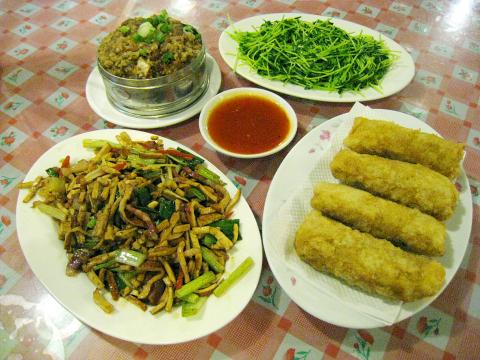Diners who stumble across Lukuang Noodle Shop (陸光麵館) could feel they’ve stumbled back in time. Black-and-white photographs of Chiang Kai-shek (蔣介石) and Chiang Ching-kuo (蔣經國) and a framed diploma issued by the Whampoa Military Academy in 1938 decorate the walls. A calendar from 1970 and a rusted antique electric fan also speak of bygone times. They are all part of proprietor Li I-li’s (李毅理) effort to revive his childhood memories of life in a juancun (眷村), or veterans’ village.
Having grown up in a now-demolished military village in New Taipei City’s (新北市) Wugu District (五股), Li opened the establishment after prolific television producer Wang Wei-chung’s (王偉忠) successful television drama Time Story (光陰的故事) and sold-out theatrical production The Village (寶島一村) kindled public interest in the vanishing culture of the veterans’ communities in 2008. Since then, Lukuang Noodle Shop has quickly become a popular spot known for simple juancun fare, which costs little but tastes good.
Lukuang’s menu is handwritten on cardboard and subject to frequent change. Judging from my several visits, the stinky tofu roll with shrimp (蝦仁臭豆腐捲, NT$120) seems to be one of the perennial favorites on the restaurant’s plain round tables. The irresistible dish is composed of finely pounded stinky tofu, shrimp and chopped coriander leaves that are wrapped in a tofu sheet and then deep-fried. The flavor is pleasantly mild and should be acceptable even to those who usually find the fermented soybean product hard to swallow.

Photo: Ho Yi, Taipei Times
The Lukuang fried combo (陸光小炒, NT$180) is a saliva-inducing example of northern Chinese-style home cooking that delights the taste buds with bustling flavors of sliced dried tofu, preserved pork, celery, scallion and chili. The eatery’s rendition of steamed spareribs (粉蒸排骨, NT$100) uses less chili than most versions and lean meat. The ribs are cooked to a lightly dried perfection and served on a bed of sweet potato chunks.
Lukuang’s biggest surprise, however, comes in the inconspicuous form of dumplings (NT$6 each). Its leek dumplings are among the best I have tried: The vegetable’s piquant taste is subdued, allowing the juicy stuffing to diffuse in the mouth.
The menu also features a few varieties of noodle dishes that are prepared at a noodle stand outside the eatery’s wooden entrance door. Inside, a cabinet displays a selection of luwei (滷味), or soy sauce-marinated snack food, that ranges from pig tongue and intestines to tofu and vegetables.
Lukuang is a two-minute walk from the intersection of Civic Boulevard (市民大道) and Dunhua South Road (敦化南路). Those who like what they see and eat at Lukuang may also want to check out Tsun Tzu Kou (村子口, see the Taipei Times review on April 17, 2009), another popular juancun eatery that appears frozen in the 1950s.

May 11 to May 18 The original Taichung Railway Station was long thought to have been completely razed. Opening on May 15, 1905, the one-story wooden structure soon outgrew its purpose and was replaced in 1917 by a grandiose, Western-style station. During construction on the third-generation station in 2017, workers discovered the service pit for the original station’s locomotive depot. A year later, a small wooden building on site was determined by historians to be the first stationmaster’s office, built around 1908. With these findings, the Taichung Railway Station Cultural Park now boasts that it has

Wooden houses wedged between concrete, crumbling brick facades with roofs gaping to the sky, and tiled art deco buildings down narrow alleyways: Taichung Central District’s (中區) aging architecture reveals both the allure and reality of the old downtown. From Indigenous settlement to capital under Qing Dynasty rule through to Japanese colonization, Taichung’s Central District holds a long and layered history. The bygone beauty of its streets once earned it the nickname “Little Kyoto.” Since the late eighties, however, the shifting of economic and government centers westward signaled a gradual decline in the area’s evolving fortunes. With the regeneration of the once

The latest Formosa poll released at the end of last month shows confidence in President William Lai (賴清德) plunged 8.1 percent, while satisfaction with the Lai administration fared worse with a drop of 8.5 percent. Those lacking confidence in Lai jumped by 6 percent and dissatisfaction in his administration spiked up 6.7 percent. Confidence in Lai is still strong at 48.6 percent, compared to 43 percent lacking confidence — but this is his worst result overall since he took office. For the first time, dissatisfaction with his administration surpassed satisfaction, 47.3 to 47.1 percent. Though statistically a tie, for most

In February of this year the Taipei Times reported on the visit of Lienchiang County Commissioner Wang Chung-ming (王忠銘) of the Chinese Nationalist Party (KMT) and a delegation to a lantern festival in Fuzhou’s Mawei District in Fujian Province. “Today, Mawei and Matsu jointly marked the lantern festival,” Wang was quoted as saying, adding that both sides “being of one people,” is a cause for joy. Wang was passing around a common claim of officials of the People’s Republic of China (PRC) and the PRC’s allies and supporters in Taiwan — KMT and the Taiwan People’s Party — and elsewhere: Taiwan and